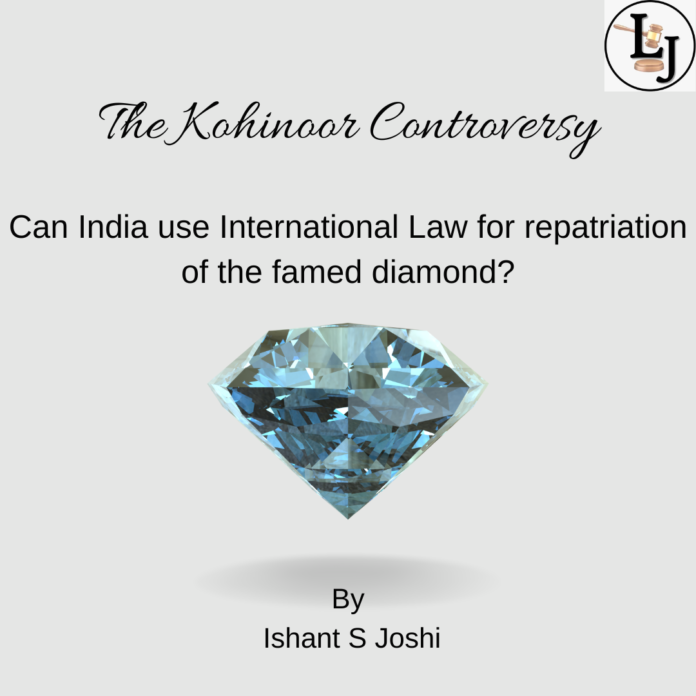[ad_1]
By Ishant S Joshi
(A student of National Law University Odisha)
Introduction
Ever since India gained independence, we Indians have longed for the Kohinoor diamond to come back to its historical homeland. The debate was reignited after the passing away of Queen Elizabeth II. Presently, the famed diamond sits in the Jewel House at the Tower of London.
The world has gone through a transformative change since WW II wherein former conquering colonial states such as the UK have sought to save their international goodwill in the changing international landscape. They have tried to do so by leaving conquered countries or by returning stolen/looted cultural property to their country of origin. Against this backdrop, a question arises as to whether India can use the international law framework to acquire the Kohinoor diamond. There are several factors to consider here, and the answer is dilemmatic.
Historical Background
Kohinoor, meaning “mountain of light” was mined in present-day Andhra Pradesh. The first recorded owner of the diamond was Rajah of Malwa. Mughal Empire was also in possession of the Kohinoor before the ownership was passed to Maharaja Ranjith Singh. Events in the Punjab empire resulted in a five-year-old Duleep Singh becoming the emperor and the owner of the diamond.
After the second Anglo-Sikh war, the East India Company made a nine-year-old kid sign a treaty/contract transferring Kohinoor’s ownership to the company (Article III of the treaty pertains to Kohinoor). From there, the diamond found its way to London and has been there ever since. The treaty/contract is disputed as the company made a nine-year-old (a minor) sign a contract under duress as a minor lack the capacity to enter into a contract. Moreover, since the treaty was entered into by Duleep Singh under duress, such a treaty also lacks any contractual legal backing. In an RTI reply, the Archaeology Survey of India also corroborated and held that the diamond was not handed over to the British “on the wishes of Duleep Singh.” The treaty shall have no supporting basis as far as UK’s claim over the diamond is concerned. However, UK’s claim rests upon the theory of “spoils of war” which refers to the notion that any profits extracted from a war shall go to the winning side, and hence, the UK shall have the ownership of Kohinoor. This is where the question of using IL comes into the picture which has developed significantly in the past century. Can India acquire the diamond back?
International Law Provisions
Assessing the current international legal framework, India has two courses of action it can pursue to acquire the diamond back: the first option will play out inside the walls of the International Court of Justice (hereinafter “ICJ”), and the second option will require both the parties (India and UK) to seek restitution of the diamond back to India.
Both will be difficult to pursue.
Now let us discuss the prospects of both the Options
Pursuing Option 1:
Article 93 of the UN Charter grants the ICJ power to hear cases between two nation members. India can use this provision to drag the UK to the ICJ. The case will be decided by applying appropriate international customary law, treaties, and conventions. This established legal norm is drawn from Article 38 of the ICJ Statute, which talks about sources of international law for the Court to follow while overseeing proceedings between members of the UN.
Currently, there does not exist international customary law in the instant matter.
Before triggering treaties, we shall note that almost all the treaties and conventions are skewed in favor of the former conquering colonial states. Laws pertaining to the restitution of cultural property are designed in such a manner that it protects the commercial interests of the country possessing the cultural property.
However, we shall scrutinize the treaties that India can utilize in ICJ.
India and UK are signatories to the 1970 convention on the Means of Prohibiting and Preventing the Illicit Import, Export, and Transfer of Ownership of Cultural Property (hereinafter “1970 convention”). Under the same, India can confidently prove that the Kohinoor qualifies as a cultural property using Article 1(a) of the 1954 Hague Convention and Article 1 of the 1970 convention since Kohinoor has historical and cultural significance for India. Further, Article 2 of the 1970 convention recognizes that “illicit transport of cultural property is one of the main causes of the impoverishment of the cultural heritage” and that state parties shall make necessary reparation. India can use Article 3 of the 1970 convention to confidently argue that the transfer of the Kohinoor from India to the UK was indeed illicit. India can make a good case in the ICJ that Kohinoor was illicitly transferred from India as a nine-year-old kid and was made to sign a treaty under duress. As for the spoils of war theory, India can outright reject the theory. India can argue that cultural property does not come within the confine of the theory as the looted cultural property does not contribute to increasing the enemy’s strength. Also, the contemporary legal landscape does not support such a colonial theory.
It must also be noted that the UK strongly protested Napoleon’s looting and seek restitution of the looted cultural property. Arthur Wellesley, Commander of Britain forces who defeated Napoleon in Waterloo stated that artistic treasures should be returned to the country of origin and Lord Castlereagh, a British diplomat, claimed that “returning the plundered artifacts to the territories of origin was the only guide to justice.” India can use this to break down the spoils of war theory propagated by the UK.
Using the abovementioned supporting elements, India might have a compelling case in ICJ.
However, as has been mentioned, almost all the treaties are skewed in favor of the former conquering colonial states. This is partly because many of the former conquering colonial states (such as the UK) spearheaded the development of such treaties.
In the instant matter, Article 7(b)(ii) of the 1970 convention states that the state parties to the 1970 convention are required to take steps to return illicitly transferred cultural property to the state party of origin after the entry into force of the convention. This breaks down India’s case in ICJ. The insertion of such a provision defeats the purpose of the convention as most of the cultural property that was looted happened majorly in the past few centuries.
Similarly, Article 10 of the UNIDROIT Convention on Stolen Or Illegally Exported Cultural Objects 1995 (to which India and the UK are not signatories) holds that the provision of the convention applies only after the entry into force of the convention.
There are not many other treaties that India can use in ICJ. Hence, currently, India does not have any concrete customary law or treaty that will help its case in ICJ.
Pursuing Option 2:
Within the current international legal framework, India has only one feasible option that it can exercise to acquire Kohinoor back. It is to enter into a special agreement with the UK.
Article 15 of the 1970 convention states that “Nothing in this Convention shall prevent State parties thereto from concluding special agreement among themselves …regarding the restitution of cultural property…”. This provision will allow India to enter into a special agreement with the UK to acquire Kohinoor.
But Article 15 depends on the willful participation of the UK. Until then, Article 15 will have no usage for India.
Conclusion
Unfortunately, the current international legal framework does not provide any concrete options for India to exercise to acquire Kohinoor back. There is no sturdy legal arsenal available for India.
Presently, it will be in India’s interest if it does not initiate any legal action against the UK on an international scale. With the law favoring the UK, it’s a high probability that India might lose. This will be detrimental to India’s future Kohinoor aspiration as losing out on an international scale can put the matter to rest permanently.
India can exercise Article 15 of the 1970 convention. But as it is in international law, exercising provisions such as Article 15 will depend on the will of both parties. In the instant matter, India will have to convince the UK to come into a special agreement. That will be almost impossible since the diamond sits on the British crown. The UK will not give the Kohinoor willingly.
However, law is never static and is always evolving. So is the case with international law. International law has developed significantly since WWII. A century earlier, we wouldn’t have been even able to imagine getting the Kohinoor back. The appropriate thing for India to do is to wait for an evolved change in the international legal landscape that will benefit India. The change has to be applied to treaties and provisions which will allow for the restitution of cultural property that was stolen/looted centuries earlier. Only then, will there be a probable chance for India to succeed. Thus, as of now, there is a deadlock. Neither of the parties will risk losing the first upkeep. It is a long shot, but currently, India will have to wait before they can dream of getting the Kohinoor back with any real substance. Until provisions relating to the cultural property are strengthened in India’s favor, India’s position in the Kohinoor matter will continue to not hold much water.
[ad_2]
Source link

